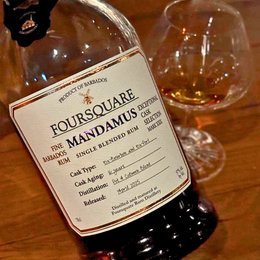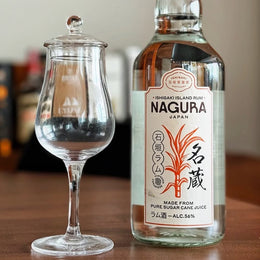Editor's note: This is Part 1 of Jigs' 3-part series on Transcontinental Rum Line (TCRL). Jigs interviews La Maison & Velier's TCRL brand manager Johann Jobello, and reviews one of TCRL's rums. Also check out Part 2 and Part 3 of this series.
Though not to the point of biased and unwise disregard for other liquor products, I’ve always held a level of fascination with independent bottlings.

Back in late 2019, around a few months after I started getting interested in whisky, I took the opportunity to find out what independent bottlings (IBs) were like, so I blindly bought a bottle of Compass Box’s Spice Tree from a local off-trade. While it wasn’t difficult to be blown away by the whisky, it was the process of learning about IBs that enthralled me with that side of the whisky industry.

Having an email conversation with Jill Boyd, one of Compass Box’s whiskymakers, was the one of the first impetuses. She accommodated my questions about the bottle that I had bought and shared with me the recipe for that specific blend. Though granted that Compass Box is somewhat distinct in its outspoken advocacy for transparency, the amount of information still launched me into learning about IBs and how they compared to original bottlings (OBs).
Today, much of that allure has calmed down. Angus MacRaild, a drinks writer who had also started his own Scotch IB brand, explains that there’s an “ocean of dullness” among today’s whiskies and that the IB sector is experiencing a painful and disheartening issue of rising prices that make it all the more difficult to release exciting bottlings at lower price points. Those factors, along with other small moments of disillusionment related to quality have tamed my enthusiasm with whisky. Don’t get me wrong; I still very much enjoy this precious hobby of mine, but I’ve been learning to better recognize the nuances of its luster.
Rum, however, has gotten me to experience a renaissance, especially because of the higher quality-price ratio that I’ve come to realize many rums have. While now might not be the best time to further detail the context of this (slight) change in direction, I’m sure you can imagine how I must’ve felt when I first had the opportunity to try out IBs of rum.
Enter: Transcontinental Rum Line (TCRL). Launched in 2016 to celebrate the 60th anniversary of La Maison du Whisky (LMDW), TCRL is one of LMDW’s IB brands and is specifically focused on sourcing and releasing rum. TCRL aims to primarily showcase rum’s variety and the level of quality in those variations, a goal that conveys their educative ethos.
I recently had the pleasure of privilege of speaking with Johann Jobello, the current product manager of TCRL. During our chat, Johann shared a wealth of information and insights on TCRL’s production process, so I’d like to share that conversation with you. Similar to a previous set of articles I’ve written, instead of abbreviating his answers, I’ll present the entirety of our talk in three parts, each with a review of a TCRL bottling. This piece constitutes the first part.

There are classic rums from rum-producing countries like those in the Caribbean and South America, but when it comes to Asia or Oceania – places that people don’t have in mind when talking about rum – we’re happy to say that we plan to release rums from them in the near future.
– Johann Jobello, Rum Product Manager & US Market Coordinator for La Maison & Velier
Stay tuned for parts two and three of this series of pieces on Transcontinental Rum Line.

Transcontinental Rum Line Trinidad 2006 – Review
This release is a molasses-based single traditional rum (using the Gargano classification) or a single traditional column rum (using The Whisky Exchange’s classification) distilled in 2006 by Angostura Distillery, in Trinidad and Tobago. Bottled from a fourth batch of casks, this was first aged for seven years in Trinidad and Tobago before aged in Liverpool, UK, for under five years. It is bottled at 56.5% strength.
Color: Dirty copper.
Nose: A refreshingly novel first impression of almonds and think peanut sauce used to cook kare-kare, a kind of Filipino stew. Mocha sneaks in, bringing with it cacao nibs, toasted whole wheat pandesal, and sweet tonkatsu sauce mixed with toasted sesame seeds. Brief highlights of sesame oil. There are also elusive touches of cumin, eucalyptus, and oak. However, these different aromas don't jump out that easily.

Palate: Mocha and tira-tira, chewy Filipino candy akin to honeycomb. The progression is slow, moving into the same tonkatsu sauce, chocolate-covered peanuts, and touches of nutmeg. Medium-roasted liberica coffee beans. Overall, the palate is definitely more homogeneous than the nose.

Finish: The finish is medium in length and has a familiar subtle nuttiness – a pretty plain ending.

The fairly unique first impression was a nice surprise. It’s always a plus when liquor so easily reminds me of my culture’s cuisine. However, I do wish the flavor development followed through further; I feel that I would’ve enjoyed this more if the striation among its flavors was a little more distinct and if the finish had more than just the nuttiness. I bought this bottle for around US$84, and I think I’ll be fine with not buying another bottle of this one. With that said, I quite easily went through this bottle, and while that might indicate that it isn’t one of those very special rums that I want to drink slowly in order to savor it over the years, it’s certainly a rum that, in a pinch, is a good and steady choice to reach for. It’s worth trying if you’re interested in giving rum IBs a try, too.

The Brown Dram
A Filipino living in Metro Manila, Jigs is a whisky and rum enthusiast. His passion for spirits has led him to develop interests in photography and, now, writing. Reach him and check out his work on Instagram @thebrowndram!







